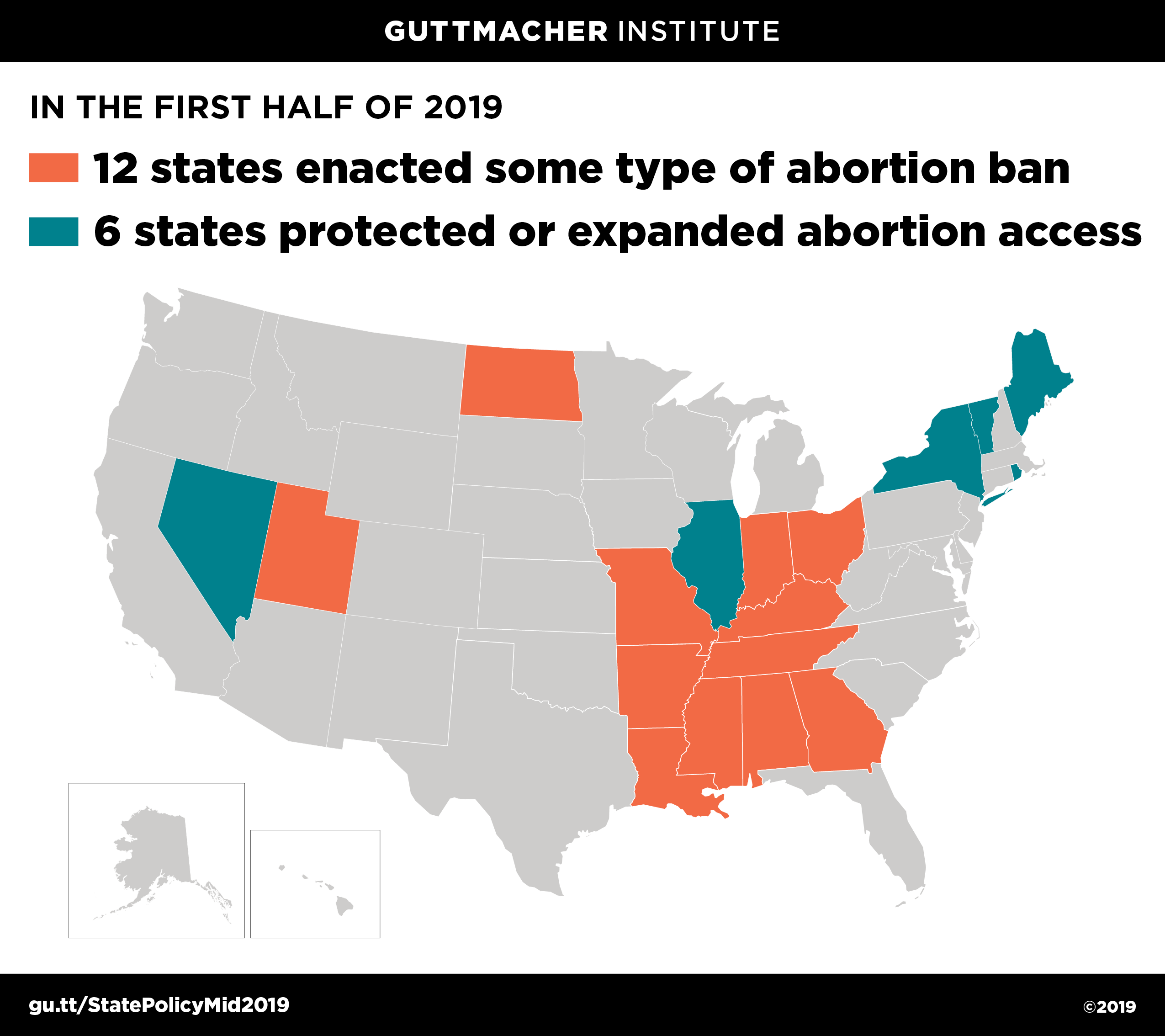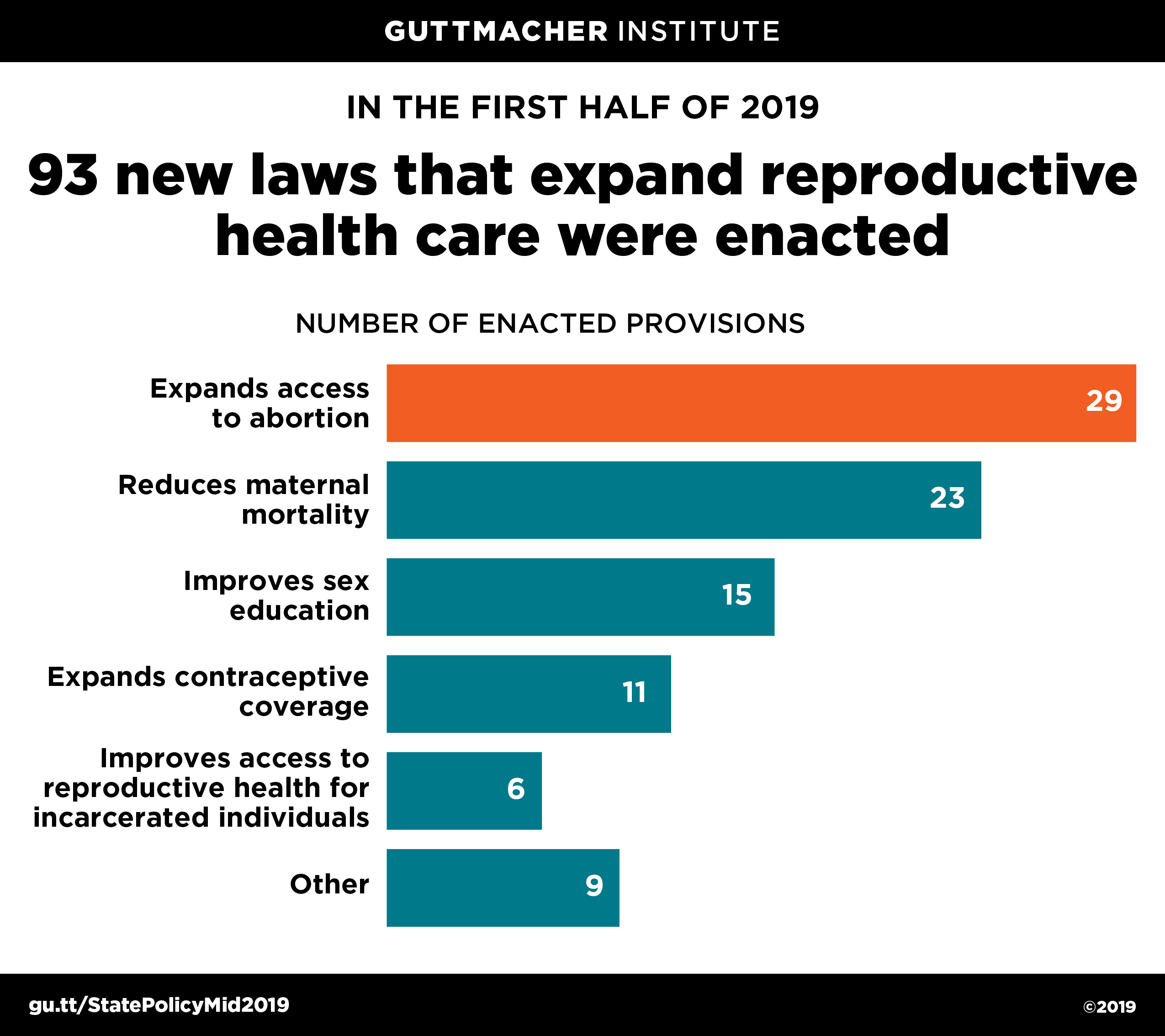Updated November 2019 to reflect that there were 25 abortion bans enacted in 2019.
The first six months of 2019 threw the state-level divide on abortion policy into sharp relief. Spurred by a more conservative U.S. Supreme Court, abortion rights were center stage in many state legislatures.
State legislatures across the South, Midwest and the Plains enacted 58 abortion restrictions, 25 of which would ban all, most or some abortions. This surge in abortion bans is a distinct departure from the strategy deployed by abortion opponents for decades, which was to adopt incremental abortion restrictions with the cumulative impact of denying care to patients and forcing clinics to close. This approach had led to passage of laws that were less likely to be challenged in the courts than outright bans.
The much more radical strategy of enacting abortion bans hinges on the hope that these bans will be the subject of court cases that will give the U.S. Supreme Court an opportunity to undermine or overturn long-standing constitutional protections for abortion. However, both strategies have the same goal—making abortion impossible to both provide and obtain.
Moving in the opposite direction are state legislatures primarily in the Northeast and West, along with Illinois. These legislatures have enacted legislation that protects abortion rights and advanced measures that expand access to contraceptive services and sex education. In fact, more proactive legislation, including measures on sex education and contraception access, was enacted in the first six months of 2019 than abortion restrictions and bans. So far this year, states have enacted 93 proactive provisions, including 29 that protect abortion rights, 23 to decrease maternal mortality, 11 that increase access to contraceptive services and 15 that improve sex education.
Abortion Restrictions
From January through June 2019, 58 abortion restrictions have been enacted in 19 states, including 25 abortion bans.
Abortion Bans
None of the abortion bans enacted in 12 states are currently in effect, either because they have been challenged in court or because the effective date of the legislation has not yet been reached. The only abortion ban to be vetoed this year was a Montana ban on abortion at 22 weeks of pregnancy.
- Gestational age bans were enacted in nine states: Alabama enacted a total ban on abortion. Georgia, Kentucky, Louisiana, Mississippi and Ohio banned abortion at six weeks of pregnancy, based on when a fetal heartbeat can be detected. Missouri banned abortion at eight weeks and included additional bans at different gestational ages in anticipation of litigation. Arkansas and Utah banned abortion at 18 weeks of pregnancy.
- Indiana and North Dakota banned the method that is the standard of care for surgical abortion after about 14 weeks of pregnancy. Two other states currently have a ban in place on this method of abortion.
- Arkansas, Kentucky, Missouri and Utah banned abortion of a fetus that has or may have Down syndrome. In addition, Kentucky and Missouri banned abortion based on the race or predicted sex of the fetus, and Kentucky banned abortion for a diagnosis of a genetic anomaly. (Eight states currently ban abortion for purposes of sex selection; one of those states also has a ban based on race selection, and another of those states has a ban in effect based on genetic anomaly.)
- Arkansas, Kentucky, Missouri and Tennessee adopted legislation that would ban abortion if the U.S. Supreme Court overturns Roe v. Wade. (With these additions, eight states have "trigger bans" in place.)
Abortion Counseling
Since 2015, a handful of states have required that abortion counseling include information on the potential to stop the completion of a medication abortion after taking the first drug of the two-drug regimen—a claim that is not supported by credible scientific evidence.
This year, four states (Kentucky, Nebraska, North Dakota and Oklahoma) enacted this counseling requirement, and Arkansas amended an existing law that mandated this type of counseling. These laws will require medical providers to inform patients about the potential to reverse a medication abortion as part of preabortion counseling and require that the state-provided counseling materials include this information. The amendment to the Arkansas law requires that patients also be given written information after taking the first drug, in addition to information conveyed in the preabortion counseling and the state materials. In Kansas, the governor vetoed legislation that would have required similar counseling and a veto override attempt failed by one vote.
Abortion Protections
As legislators in other states attack abortion rights, progressive state legislators are responding to a more conservative U.S. Supreme Court by enacting protections and expanding availability. So far this year, six states protected or expanded abortion access.
- New York enacted a law that affirms the right to abortion up to the point of fetal viability and when a patient’s life or health is at risk at any stage, and protects the right to contraception, pregnancy and sterilization. The new law also prohibits interference in accessing services related to these rights and sets the stage for provision of abortion by advanced physician assistants, certified nurse midwives and advanced practice nurses. Illinois and Vermont enacted legislation similar to the New York law. Rhode Island’s new law protects the right to abortion up to fetal viability and when necessary to protect a patient’s life or health, but maintains a physician-only provision requirement; it also protects the right to pregnancy and contraceptive care. With the addition of Illinois, New York, Rhode Island and Vermont, 13 states have statutory protections for abortion rights.
- New laws in Maine allow physician assistants and advanced practice nurses to provide abortion care and require Medicaid and private health insurance plans to cover abortion.
- Nevada repealed its unenforced criminal abortion statute, removing a legal mechanism for punishing abortion providers if Roe v. Wade is overturned.
Other Proactive Legislation
Beyond abortion, states have also enacted legislation that seeks to reduce maternal deaths, and protects and expands access to contraception and sex education.
Reducing Maternal Mortality
According to the Centers for Disease Control and Prevention, the maternal mortality ratio for black women was more than three times as high as the ratio for white women in 2011–2015. This large racial disparity has not decreased since at least the 1940s, when the maternal mortality ratio was 2.4 times higher for black women than white women. Racial disparities in health care provision and evidence of poor maternal health outcomes for certain populations reflect broader inequities and shed light on structural racism in the United States and how health care providers’ implicit bias may be contributing to these disparities.
In recent years, and continuing in 2019, reducing maternal mortality along racial and ethnic lines has been a focus of state legislatures across the country. The efforts take two overall approaches to improving maternal health: establishing or reviving lapsed statewide commissions that investigate maternal deaths, make recommendations to reduce maternal mortality rates, and address disparities in health outcomes based on race and ethnicity; and expanding access to health care and improving the quality of maternal health services.
- In the first half of 2019, seven states (Arkansas, Colorado, Idaho, New Mexico, Nevada, Oklahoma and Virginia) established maternal mortality commissions. These panels are generally tasked with reviewing maternal deaths and providing recommendations to reduce maternal mortality.
- Another seven states (Georgia, Maryland, New Jersey, South Carolina, Texas, Washington and West Virginia) enacted laws that support the work of existing commissions. The Maryland commission will now provide information and recommendations about maternal mortality to state agencies and local groups as a way to promote an integrated public health response and a related program will study and make recommendations to reduce disparities in maternal mortality rates, including social determinants related to maternal mortality. The new law in Texas requires collection of information on maternal care and postpartum depression, and evaluation of the use of telemedicine for pregnancy and postpartum care.
- New laws in eight states (Colorado, Illinois, Indiana, Minnesota, New Jersey, Texas, Virginia and West Virginia) aim to expand access to and improve the quality of health care to support positive maternal health outcomes. In four of these states, Medicaid will be expanded to provide additional services: Illinois will expand Medicaid coverage for pregnant women from 60 days postpartum to 12 months postpartum, New Jersey’s Medicaid will include doula services, Texas will require Medicaid to improve prenatal and postpartum care and require statewide initiatives to improve the quality of maternal health services and outcomes, and West Virginia’s Children’s Health Insurance Program will include pregnant women up to 300% of the federal poverty guidelines and the state Medicaid program will include pregnant women up to 185% of the guidelines.
- Four states (Colorado, Indiana, Minnesota and Virginia) expanded access to health care for pregnant patients who use substances through improved referral and funding for services.
Sex Education
State legislatures continue to focus on sex education, with legislation enacted in six states and the District of Columbia. State legislation passed this year primarily focuses on expanding the scope of sex education to provide information on sexual consent, include LGBT students, and promote healthy and violence-free relationships. Including these new laws, 24 states and DC require sex education.
- New laws in New Jersey and DC require education on sexual consent. The New Jersey law includes instruction on the right to refuse unwanted sexual activity and the importance of respecting others’ refusals. In DC, instruction must cover personal boundaries and healthy relationships.
- A new law in Tennessee encourages schools to provide age-appropriate sexual violence awareness education in grades 7–12.
- In Virginia, a new law requires evidence-based and age-appropriate instruction on human trafficking.
- Arizona repealed a provision of the state’s sex education law that prohibited HIV/AIDS instruction provided to students in grades K–12 from offering positive information about homosexuality.
- Utah amended its sex education law so that schools may, but are not required to, include information on contraception.
- Colorado expanded requirements for sex education when provided in schools. Currently, sex education must be medically accurate and cover contraceptives, abstinence, sexual and teen dating violence prevention and healthy decision making. The new law also requires sex education to include information on all methods of preventing pregnancy and STIs and address adoption, abortion, parenting and infant abandonment without bias. The curriculum must also cover recognition and withdrawal of sexual consent. In addition, the sex education material is not allowed to endorse a religion, use shame-based or stigmatizing language, use gender stereotypes or exclude LGBT individuals.
Insurance Coverage of Contraceptives
By the beginning of July, four states that have existing guarantees for contraceptive coverage strengthened and expanded those requirements. There are currently 29 states that have a contraceptive coverage guarantee.
- Amendments to New York and New Mexico law require private health insurance plans to cover, without cost sharing, all FDA-approved contraceptives, emergency contraception and sterilization. In New York, the amendments also require coverage for over-the-counter methods and allow enrollees to obtain a 12-month supply of their contraceptive method at one time. In New Mexico, coverage for male sterilization and male condoms is excluded from high-deductible insurance plans. Both states’ Medicaid programs are now required to cover up to a 12-month supply of contraceptives dispensed at one time.
Other Measures
A new Washington state law bars private health insurance plans, student health plans and Medicaid from automatically denying reproductive health care services to enrollees that are usually or entirely covered based on gender. The new law also requires coverage of condoms, services related to sexual assault, well-person preventive visits, prenatal vitamins and breast pumps.

